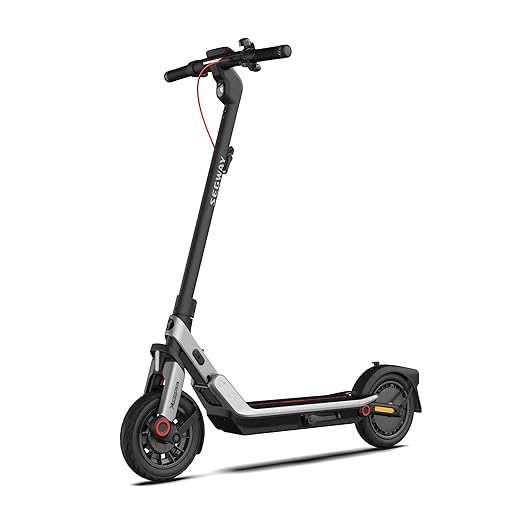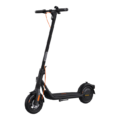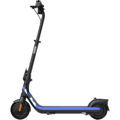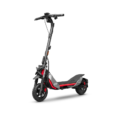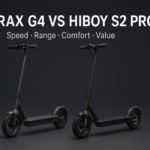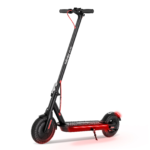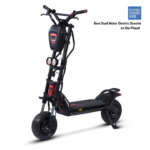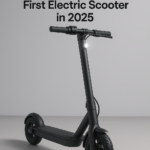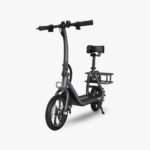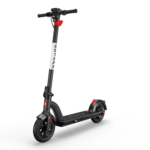- Home
- Scooters
- Electric Scooters
- Segway Ninebot E3 Pro
Segway Ninebot E3 Pro
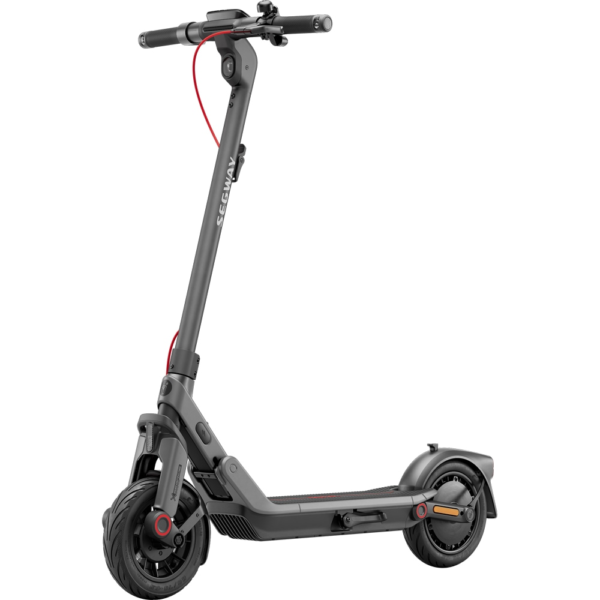

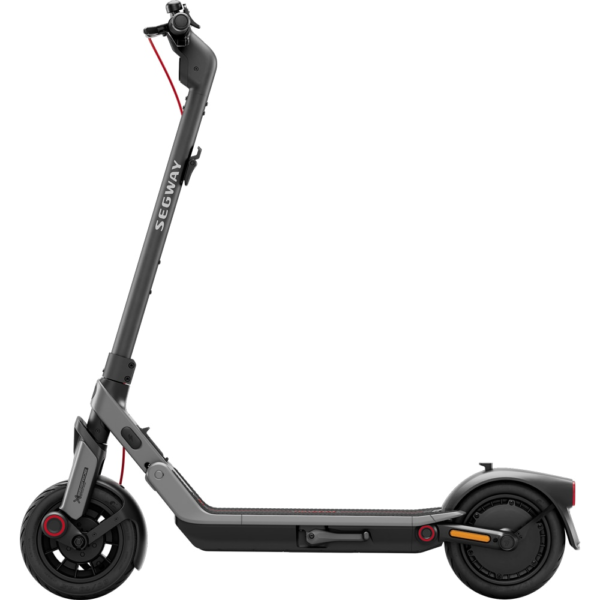
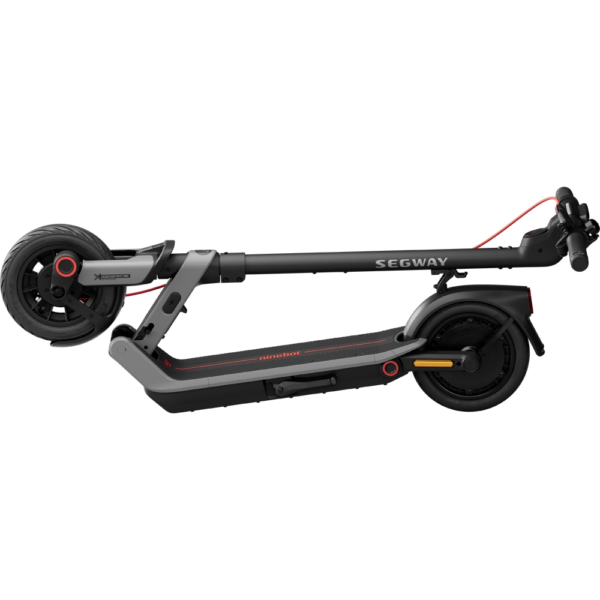
- Battery Range: 34 miles (55 km)
- Top Speed: 20 mph (32 km/h)
- Motor Power: 400 W
- Weight Capacity: 220 lb (100 kg)
- Charging Time: ~7 h
- Scooter Weight: 39.5 lb (17.9 kg)
PROS
- Dual elastomer suspension
- 10″ tubeless tires
- Front drum + rear electronic brake
- Apple Find My support
- IPX5 body (IPX7 battery)
- Magnesium-alloy frame
CONS
- Single mechanical brake (drum) up front
- No official folded weight hook
- Top speed below some commuter rivals
Table of contents
- What Is the Segway Ninebot E3 Pro?
- How the Segway Ninebot E3 Pro Works
- Key Specifications
- Design & Build Quality
- Performance Fundamentals
- Battery, Range & Efficiency
- Ride Quality & Comfort
- Braking & Safety Features
- Portability & Daily Usability
- Maintenance & Care
- Weather & Seasonal Considerations
- Segway Ninebot E3 Pro vs Alternatives
- Who the Segway Ninebot E3 Pro Is (and Isn’t) For
- FAQs
- Glossary
- Final Thoughts
The Segway Ninebot E3 Pro is a compact, dual-suspension commuter scooter built for daily rides, school runs, and short city hops. It blends stability tech, app-enabled features, and a practical folding design that fits small apartments and office corners. Moreover, if you want an easy, confidence-inspiring ride that still feels lively, the E3 Pro hits a sweet spot for everyday use.
What Is the Segway Ninebot E3 Pro?
The E3 Pro sits in Segway’s urban lineup as a light, sturdy, and approachable e-kick scooter for adults and teens (regional age limits apply). It prioritizes balance and predictability over raw speed. Consequently, it feels calm at cruise, yet it remains nimble in traffic. Additionally, its dual elastomer suspension helps smooth out rough pavement, and the 10-inch tubeless tires add grip while reducing puncture risk.
There are regional variants. In many EU markets, you’ll see E3 Pro E with a capped top speed of 25 km/h (15.5 mph) and a theoretical 55 km (34 mi) range in Eco conditions. In North America, the E3 Pro lists up to 20 mph (32 km/h) with a 34-mile max range under controlled tests. Because differences reflect local laws and test protocols, the core platform, ride feel, and feature set remain consistent across regions. As a result, shoppers can focus on use-case and comfort rather than chasing minor variant labels.
How the Segway Ninebot E3 Pro Works
At heart, the E3 Pro is simple; however, the pieces work together in a polished way:
- Motor & Controller: A rear hub motor delivers brisk starts and steady hill climbing. A smart controller meters current smoothly, so acceleration builds without lurching. In practice, think of the controller as a conductor, keeping the motor, battery, and traction control in sync.
- Battery & BMS: A 36-volt lithium-ion pack sits in the deck. Meanwhile, the battery management system (BMS) monitors temperature, voltage, and current, balancing cells for longevity. Because the pack is sealed and rated for splash resistance, it tolerates typical light rain, though you should still avoid deep water.
- Throttle: A thumb throttle on the right grip lets you dose power with fine control. Hold steady to cruise; feather it in stop-and-go flows. Therefore, low-speed maneuvering stays easy.
- Brakes & Regen: Up front, a drum brake provides mechanical bite with consistent modulation in all weather. At the rear, electronic regenerative braking helps slow the scooter while recapturing a bit of energy. Since the two systems blend together, you get predictable deceleration even on slick roads.
Overall, the hardware works as a coordinated system. Furthermore, the stability algorithms (Segway’s SegRide™ and TCS traction control) add a subtle, almost invisible layer that calms steering inputs and improves grip when surfaces get dusty or wet. Consequently, the scooter feels composed in conditions that often unsettle lighter platforms.
Key Specifications
Figures below reflect the official platform data common to the E3 Pro family. Where regional differences exist (e.g., EU/EU-E vs US), both metrics are shown so you can compare quickly.
| Block | Details |
|---|---|
| General | Model: Segway Ninebot E3 Pro (EU variant often shown as E3 Pro E). Class: Adult e-kick scooter. Max payload: 100 kg / 220 lb. Recommended age: 14+ (varies by region). 3-inch cockpit display. Stability Enhancement (SegRide™) and Traction Control (TCS). |
| Performance & Power | Top speed: 25 km/h (15.5 mph) EU; 20 mph (32 km/h) US. Nominal motor power: 400 W. Max power: 800 W. Max grade: 18% (≈10°). Rear-wheel drive. Riding modes: Eco, Standard/Drive, Sport, plus Walk. |
| Battery, Charging & Electrical | Pack: 368 Wh (36 V, ~10.2 Ah). Typical charge time: ≈7 hours with the included charger. Battery IP rating: IPX7 (pack), scooter water resistance IPX5 (regional pages). App connectivity (Segway Mobility). Apple Find My supported. |
| Build & Dimensions | Frame: magnesium-aluminum alloy. Tires: 10-inch tubeless (self-sealing compound). Suspension: front & rear elastomer. Dimensions (unfolded): 1165 × 563 × 1235 mm (≈ 45.9 × 22.2 × 48.6 in). Folded: 1235 × 564 × 445 mm (≈ 48.6 × 22.2 × 17.5 in). Net weight: ≈17.9 kg (≈39 lb). |
| Safety & Control | Brakes: front drum + rear electronic regen. Headlight: 4 W; rear brake light. Certified reflectors (E-mark, region-dependent). Turn indicators in many regions. Water resistance: IPX5 (scooter), IPX7 (battery). |
| Features & Extras | 256-color under-deck ambient light (varies by region). Traction Control System (TCS). SegRide™ stability tuning. App-based settings, riding records, and diagnostics. Cruise mode availability can vary by region/firmware due to local rules. Optional external battery in some markets. |
| Warranty & Compliance | Compliance: CE/UKCA where applicable; certified reflectors; Segway cites TÜV Rheinland “Range at Max Speed” quality-mark for endurance methodology. Warranty terms vary by region and retailer; consult your local policy. |
Design & Build Quality
Segway designed the E3 Pro for daily durability and tidy storage. The frame uses a magnesium-aluminum alloy that keeps weight down while resisting everyday knocks. In addition, the deck feels solid underfoot and offers enough space to stand with a staggered stance, which helps balance your weight over the rear hub motor.
The stem locks with a dual-unlock mechanism. Because it’s a two-step fold, it resists accidental unlatching while still folding quickly once you learn the sequence. Meanwhile, the 3-inch display sits high on the cockpit for quick glances. It is bright in daylight, and the digits remain readable at arm’s length. The bar-end turn indicators (when included regionally) are integrated cleanly, and the bell (where fitted) is within thumb reach.
Fit and finish feel mature. Panel gaps are tight, wiring is tucked, and the charging port uses a firm cap that seals with a positive click. Moreover, the tubeless tires and elastomer suspension soak up chatter that would otherwise rattle a less refined scooter. As a result, the E3 Pro feels composed rather than flimsy.
Performance Fundamentals
Acceleration feel. From a standstill, the E3 Pro pulls smoothly. It doesn’t surge. Instead, it ramps, which helps on crowded paths. Additionally, Sport mode adds snap for merging into traffic lights or crossing intersections quickly. Because torque is rear-biased, the front stays planted over small bumps as you launch.
Cruising stability. At neighborhood speeds, the steering is calm. The SegRide™ stability tuning and the curved handlebar help the scooter resist twitchiness from road seams. Consequently, it holds a line with little input, which reduces fatigue on longer rides. Furthermore, the low vibration through the deck keeps your stance relaxed.
Hill-climb behavior. On 7–10% grades, the E3 Pro holds a steady pace in Sport. Expect speed to dip on longer climbs, especially with heavier riders or headwinds. Nevertheless, starting on a hill remains manageable; give a short push-off, roll into the throttle, and let the controller and traction control hook up. On steeper, short ramps, it may slow near the top, yet it keeps churning without drama.
Battery, Range & Efficiency
The deck battery is rated at 368 Wh (36 V). In EU-style testing, the E3 Pro cites up to 55 km (34 mi) at 15 km/h (9.3 mph) in Eco mode. At a higher cruise near 25 km/h (15.5 mph), the listed endurance is up to ~40 km (25 mi). In the US, marketing material highlights 34 miles maximum range under controlled conditions. Naturally, actual results will vary.
What affects real-world range?
- Rider mass: Heavier riders draw more watt-hours per mile. Consequently, total range drops.
- Speed: Aerodynamic drag rises with speed; therefore, Sport mode shortens range.
- Terrain & starts: Hills, frequent stops, and rough surfaces increase consumption.
- Temperature: Cold batteries supply less energy; conversely, hot weather can trigger protective limits.
- Tire pressure: Under-inflation increases rolling losses; proper pressure improves efficiency.
Charging habits for longevity. Lithium-ion batteries prefer gentle care. After hard rides, let the scooter cool to room temperature before charging. For daily commuting, try to avoid storing at 100% for days on end. If you won’t ride for a while, leave the charge around 40–60% and top up monthly. Because the BMS balances cells near the top of the charge, a full charge every few weeks helps maintain healthy cell alignment. Finally, always charge in a dry, ventilated space.
Some regions market an optional external battery that extends range; availability depends on your market timeline. If offered, it can push the theoretical range notably higher, but it adds a small amount of weight. Therefore, decide based on commute length and carry needs.
Ride Quality & Comfort
Tires. The 10-inch tubeless tires use a self-sealing layer to help plug minor punctures from small debris. That design reduces roadside fixes and helps the tire hold air better over time. Because they are tubeless, pressure management is critical. Therefore, check the sidewall range and use a gauge; keeping pressures even on both sides preserves neutral steering.
Suspension. The front and rear elastomer units are maintenance-light and quiet. They filter buzz from brickwork, joints, and small potholes. Of course, large, sharp-edged holes still warrant caution—this is a compact commuter, not a long-travel off-road machine—but the dual setup clearly reduces foot and hand fatigue on mixed urban surfaces. As a result, longer rides feel less taxing.
Ergonomics. The deck height and bar reach fit a wide range of riders. The curved handlebar helps keep your wrists neutral, and the thumb throttle angle feels natural. Stem flex is modest; you’ll notice a small amount when you load the front over speed bumps, yet it remains well controlled at cruise. Additionally, the grippy deck coating keeps your stance stable in light rain.
Braking & Safety Features
The E3 Pro blends a front drum brake with rear electronic regenerative braking. Drum brakes are enclosed, so they stay consistent in wet weather and need little routine maintenance. Modulation is predictable: you get a gentle initial bite followed by firmer deceleration as the lever travel increases. Because regen contributes to slowing, you can ease lever effort while still shedding speed efficiently. Therefore, downhill control feels confident without cramped hands.
For visibility, the scooter includes a 4 W headlight, a rear brake light, and certified reflectors. Many regional packages also include turn indicators integrated at the bar ends and on the rear. Moreover, the under-deck ambient light (256 colors in certain regions) boosts side visibility at night. Water resistance is noted as IPX5 for the scooter, with an IPX7 rating for the battery pack. Consequently, you can ride in light rain if rules allow, but you should avoid standing water.
Portability & Daily Usability
Portability is where the E3 Pro shines. At roughly 17.9 kg (≈39 lb), it’s light enough for short stair carries. The dual-unlock fold is quick once learned, and the folded footprint—about 1235 × 564 × 445 mm—slides under desks or against walls without hogging space. Therefore, storage in small apartments and offices stays simple.
For intermodal travel, the folded height is low enough to rest on train or bus floors without tipping. Additionally, because the 10-inch tubeless tires resist pinch flats, you can roll confidently over cobbles and curb cuts. For security, develop a routine: take the charger with you, fold and park in visible spots, and consider a hardened U-lock or folding lock through the frame when you can. Apple Find My support adds a helpful layer of location awareness; however, you should still lock the scooter whenever possible.
Maintenance & Care
The E3 Pro aims to be low-maintenance, yet a simple schedule keeps it running like new. Accordingly, use this rhythm:
- Before rides (weekly if you ride daily): Check tire pressure, lights, and brakes. Shake the stem lightly; if you feel play, tighten the latch as the manual describes.
- Every 2–4 weeks: Inspect fasteners on the stem clamp, fender mounts, and axle areas. Wipe dust from the deck and test the bell/indicators.
- Every 2–3 months: Clean and lightly lube exposed hinge pins (avoid the brake surfaces). Run an app health check and apply firmware updates when offered.
- Tires: Visual-check tread and sidewalls. Because these are tubeless, sealant may self-plug tiny punctures; for larger punctures, follow approved repair steps or replace the tire.
- Brakes: Drum systems are stable; if the lever travel increases over time, adjust the cable at the caliper end per the manual.
- Battery: Store around 40–60% if idle for more than a month. Also, avoid full-discharge storage, which stresses cells.
With consistent attention, squeaks, slop, and premature tire wear remain rare. Moreover, firmware updates can improve behavior over time, so keep the app handy.
Weather & Seasonal Considerations
Rain. With IPX5 scooter water resistance and an IPX7 battery, the E3 Pro tolerates light rain. Still, slow down on paint lines and wet metal plates; they get slick quickly. After riding in rain, towel the scooter dry, especially around the folding joint and fasteners. Then, charge only after the pack returns to room temperature.
Heat. High ambient temperatures accelerate battery aging. Whenever possible, charge in a cool, ventilated area and avoid leaving the scooter locked in direct sun for hours. Consequently, battery health and display legibility both improve.
Cold. Range drops in low temperatures as chemical reactions slow. Pre-warm the battery indoors, then ride. After cold rides, allow the pack to slowly warm to room temperature before charging. Therefore, winter storage habits matter.
Road treatments. Salt and de-icers can corrode hardware. Rinse or wipe the scooter after exposure and dry it thoroughly. In addition, re-lube any exposed hinge pins lightly afterward.
Segway Ninebot E3 Pro vs Alternatives
Against ultralight last-mile scooters: The E3 Pro rides smoother and more stable, thanks to dual suspension, tubeless 10-inch tires, and traction control. It is heavier than ultra-light models; however, it remains manageable for brief carries.
Against mid-range commuter class: It competes on comfort and tech. Many rivals at this size lack both front and rear suspension or skip advanced stability aids. Therefore, the E3 Pro’s polished acceleration and braking tune give it a well-sorted feel for everyday city miles.
Against performance/dual-motor machines: Those climb faster and sprint harder but weigh more and take up more space. If you value portability, easy storage, and balanced manners over sheer power, the E3 Pro remains the better daily driver. Conversely, if you crave maximum thrust, a heavier class may suit you better.
Against off-road-leaning scooters: Long-travel forks and knobby tires devour trails, yet they’re overkill for city grid riding. The E3 Pro’s urban geometry, sealed drum brake, and smart traction control better match curbs, lanes, and varying asphalt. As a result, it feels calm where knobby tires can feel vague.
Who the Segway Ninebot E3 Pro Is (and Isn’t) For
Ideal for:
- Commuters who want a calm, predictable scooter for daily rides under 15–25 km (9–15 mi) round-trip.
- Students who need a compact, reliable way to cross campus and nearby neighborhoods.
- Last-mile riders who link buses or trains with a short downtown hop.
- New riders who value confident handling, strong lights, and a forgiving suspension.
Related option: If you’re shopping for a smaller, youth-friendly model, check out the Segway Ninebot C2 Pro.
Consider other classes if:
- You routinely climb long, steep hills beyond 10% grade with a heavy backpack.
- You need 40+ km (25+ mi) daily range at near-top speed.
- You want off-road suspension travel or dual-motor acceleration.
In short, if your routes mix neighborhood streets, bike lanes, and occasional cobbles, the E3 Pro is an easy scooter to live with. If your rides demand extreme range or power, a heavier platform will fit better.
FAQs
1) What does a “Segway Ninebot E3 Pro overview” usually include?
A thorough overview breaks down the core hardware (motor, battery, brakes), ride feel, maintenance, and a clear table of key data—plus real-world tips on range and care.
2) How fast does it go?
Regional rules apply. In many EU markets, it’s capped at 25 km/h (15.5 mph). In the US, listings commonly show up to 20 mph in appropriate areas. Therefore, always check local limits.
3) How far can I ride on a single charge?
Expect up to ~40–55 km (25–34 mi) under controlled conditions at modest speeds. Real-world range varies with rider mass, speed, temperature, and terrain. Consequently, planning a small buffer is wise.
4) Does it have cruise control?
A cruise mode may be present or restricted based on local regulations and firmware. Even when enabled, touching the brake or throttle usually cancels it. Therefore, use it thoughtfully in traffic.
5) Is it okay to ride in the rain?
The scooter carries IPX5 water resistance and an IPX7 battery pack rating. Light rain is typically fine, but avoid puddles and never submerge the deck. Afterwards, dry the scooter before charging.
6) How does the suspension feel?
The dual elastomer setup takes the sting out of cracks and seams. It’s tuned for city streets rather than off-road jumps. As a result, comfort remains high on mixed pavement.
7) What maintenance does it need?
Check tire pressure, lights, and the folding latch regularly. Keep firmware current, and inspect fasteners monthly. The drum brake needs little routine attention; however, cable adjustment over time is normal.
Glossary
- Ah (amp-hours): Battery capacity; how much charge a pack can store.
- Wh (watt-hours): Usable energy (volts × amp-hours); a better measure of range potential.
- Controller: The electronic brain that regulates power delivery to the motor.
- Regen (regenerative braking): Electronic braking that slows the wheel and recovers a small amount of energy.
- Stem flex: The slight bending you feel in the steering column over bumps; controlled flex improves comfort.
- IP rating: Ingress Protection; higher numbers indicate better resistance to water and dust (e.g., IPX5).
- TCS (Traction Control System): Electronic aid that reduces wheel slip on low-grip surfaces.
- SegRide™: Segway’s stability tuning for calmer steering and better disturbance resistance.
- Tubeless tire: Tire without an inner tube; uses sealant layers to self-plug small punctures.
- Drum brake: Enclosed brake that resists weather and needs minimal upkeep.
- BMS (Battery Management System): Circuitry that protects and balances the battery cells.
- Walk mode: Low-speed assist for pushing the scooter beside you.
- Ambient light: Under-deck LEDs that improve side visibility and rider presence.
- Payload: The combined weight of rider and cargo the scooter can safely carry.
- Folded footprint: The space the scooter occupies when folded—important for storage and transit.
Final Thoughts
The Segway Ninebot E3 Pro delivers calm handling, trustworthy braking, and comfort far beyond many compact commuters. Although it’s not built for extreme hills or high-speed sprints, it nails the essentials: smooth acceleration, stable cruising, practical folding, and meaningful safety features. Therefore, if your daily routes fit within its range envelope—and you value a composed, low-maintenance ride—the E3 Pro feels purpose-built for urban life.
Specifications
General
| Model The Model specifies the exact version or name of the scooter. It helps identify its unique design, features, and specifications within the manufacturer’s product line. Knowing the model makes it easier to compare options, find compatible accessories, or look up support information. | Ninebot E3 Pro |
| Brand The Brand identifies the manufacturer or company that designs and produces the scooter. A trusted brand is a sign of quality, reliability, and good customer support. Well-known brands often have higher standards for safety, performance, and after-sales service, giving you more confidence in your purchase. | Segway |
| Release Date The Release Date indicates when the scooter model was officially launched on the market. This helps you know how current the design, technology, and features are. A newer release date often means updated components, improved performance, and the latest safety or smart features. | 17 November 2025 |
| Recommended Age Recommended Age indicates the minimum age range that the scooter is designed for, based on safety, size, and ease of use. Following the recommended age helps ensure that riders can handle the scooter’s speed, weight, and controls comfortably and safely. Always check local laws and use protective gear, especially for younger riders. | +16 |
Performance & Power
| Motor Power (Wattage) What it means: The motor power, measured in watts (W), shows how strong the scooter’s electric motor is. Why it matters: Higher wattage usually means better acceleration, more torque, and improved performance on hills or rough terrain. For example, a 250W motor is good for flat city roads and light riders, while a 500W or 1000W motor provides more power for faster speeds or climbing steep inclines. | Rear hub motor, 400 W nominal (800 W peak) |
| Top Speed The Top Speed indicates the maximum speed that the scooter can reach under optimal conditions. It’s usually measured on level ground with a fully charged battery and an average rider weight. A higher top speed allows you to travel longer distances faster, but always ensure you ride within legal speed limits and your personal comfort zone for safety. | 20 mph (32 km/h) |
| Battery Capacity Battery Capacity refers to the total amount of energy the scooter’s battery can store, usually measured in ampere-hours (Ah) or watt-hours (Wh). A higher battery capacity means you can ride longer distances on a single charge, reducing the need for frequent recharging. Keep in mind that actual range can vary depending on rider weight, terrain, speed, and weather conditions. | 36 V 10.2 Ah (368 Wh) |
| Estimated Range per Charge The Estimated Range per Charge indicates the average distance the scooter can travel on a single full battery charge. This range is calculated under optimal conditions, such as flat terrain, moderate speed, and average rider weight. Real-world range may vary depending on riding style, terrain, weather, and load. A longer range means fewer recharges and greater freedom for longer trips. | 34 miles (55 km) |
| Hill Climb Ability Hill Climb Ability describes the maximum incline or slope that the scooter can handle while maintaining stable performance. It’s typically expressed as a percentage or in degrees. A higher hill climb rating means the scooter can tackle steeper hills without losing too much speed or power. Actual climbing performance may vary based on rider weight, battery charge, and terrain conditions. | 18% |
| Drive System The Drive System refers to how power from the motor is delivered to the wheels. Electric scooters typically use either a hub motor (directly integrated into the wheel) or a chain/belt drive system. A high-quality drive system ensures smooth acceleration, efficient power transfer, and low maintenance. The choice of drive system affects performance, noise level, and overall ride experience. | RWD |
Charging & Electrical
| Charging Time Charging Time indicates how long it takes to fully recharge the scooter’s battery from empty to 100% using the standard charger provided. Faster charging means less downtime and more time on the road. Actual charging time may vary slightly depending on battery capacity, charger output, and environmental conditions. | Approx. 7 hours |
| Battery Type Battery Type refers to the specific technology used in the scooter’s battery, which affects performance, lifespan, weight, and charging time. Most modern electric scooters use high-quality lithium-ion (Li-ion) batteries because they offer a good balance of energy density, durability, and low maintenance. A reliable battery type ensures consistent power delivery and longer riding ranges. | Lithium-ion with Smart BMS |
| Removable Battery A Removable Battery means the battery pack can be easily detached from the scooter for convenient charging and replacement. This feature allows you to charge the battery separately, swap it with a spare for extended range, or securely store it indoors in extreme weather. Removable batteries add flexibility and make it easier to keep your scooter powered up wherever you are. | No |
| Regenerative Braking Regenerative Braking is an energy-saving feature that converts some of the energy normally lost during braking back into battery power. When you slow down or brake, the motor works in reverse to generate electricity, which helps extend the scooter’s range and improves overall efficiency. This system also reduces wear on traditional brake components, leading to lower maintenance over time. | Yes (regenerative electronic rear brake) |
| Lighting Lighting refers to the built-in front and rear lights that enhance visibility and safety when riding in low-light conditions or at night. Good lighting helps you see the road ahead and ensures that other road users can see you. Many scooters include LED headlights, taillights, and sometimes brake lights or side reflectors for added safety and compliance with local traffic regulations. | 4 W headlight, rear brake light, integrated front & rear turn indicators, reflectors |
Build & Dimensions
| Scooter Weight Scooter Weight refers to the total weight of the scooter when fully assembled, including the battery. This affects how easy it is to carry, lift, and store the scooter when not in use. A lighter scooter is more portable and convenient for commuting, especially if you need to carry it upstairs or onto public transport. Keep in mind that a sturdy frame and quality components may add to the weight but also contribute to better durability and ride stability. | 39.5 lb (17.9 kg) |
| Maximum Rider Weight Maximum Rider Weight indicates the highest rider weight that the scooter is designed to safely support while maintaining optimal performance and stability. Staying within this limit helps ensure reliable acceleration, braking, and climbing ability, and it protects the frame, suspension, and motor from excessive strain. Exceeding the recommended limit may reduce performance and increase wear on components. | 220 lb (100 kg) |
| Deck Size Deck Size refers to the dimensions of the scooter’s standing platform. A wider and longer deck provides more foot space, allowing you to stand comfortably and adjust your stance while riding. A well-sized deck improves balance and stability, especially on longer rides or at higher speeds. Compact decks, on the other hand, help keep the scooter lightweight and portable. | Compact urban frame; stability enhancement geometry |
| Handlebar Height Handlebar Height refers to the distance from the deck to the handlebars, which affects your riding posture and comfort. An appropriate handlebar height helps you maintain good balance, reduces strain on your back and arms, and makes steering more comfortable. Some scooters have adjustable handlebars to fit riders of different heights, while others have a fixed height for a streamlined design. | Fixed; 48.6 in (1235 mm) overall height |
| Folding Mechanism The Folding Mechanism describes how easily and securely the scooter can be folded for carrying and storage. A well-designed folding system lets you quickly collapse the scooter into a compact size, making it convenient to transport on public transit, store under a desk, or fit into a car trunk. Look for sturdy latches and safety locks to ensure the scooter stays firmly in place when folded or unfolded. | 2-step folding latch |
| Dimensions Folded Dimensions indicate the size of the scooter when it’s fully folded. This measurement shows how much space the scooter will take up when stored or carried, making it easier to check if it will fit in your car trunk, under a desk, or in a closet. Compact folded dimensions are ideal for commuters who need to bring their scooter on public transport or store it in tight spaces. | Unfolded: 45.9 × 22.2 × 48.6 in (1165 × 563 × 1235 mm); Folded: 48.6 × 22.2 × 17.5 in (1235 × 564 × 445 mm) |
| Material Material refers to the primary construction materials used for the scooter’s frame and key components. High-quality materials like aircraft-grade aluminum, reinforced steel, or durable composites provide strength, stability, and a lighter overall weight. A sturdy material ensures the scooter can handle daily wear and tear while maintaining safety and performance. | Magnesium alloy |
Safety & Control
| Brake Type(s) Brake Type(s) describe the braking systems the scooter uses to help you slow down or stop safely. Common brake types include mechanical brakes (like drum or disc brakes), electronic brakes, and foot brakes. Many scooters combine multiple braking systems for added safety and shorter stopping distances. The type and quality of brakes affect your control, especially when riding at higher speeds or on slopes. | Front drum + rear electronic (regen) |
| Suspension Suspension refers to the system that absorbs shocks and vibrations while riding, providing a smoother and more comfortable ride over uneven or rough surfaces. Scooters may have front suspension, rear suspension, or dual suspension for better shock absorption and stability. Good suspension helps reduce rider fatigue and improves control, especially when riding on bumpy roads or off-road paths. | Front & rear elastomer suspension |
| Tire Type Tire Type refers to the kind of tires the scooter uses, which directly affects ride comfort, traction, and maintenance. Common types include solid (airless) tires, pneumatic (air-filled) tires, or hybrid options. Pneumatic tires offer better shock absorption and a smoother ride on rough surfaces, while solid tires are puncture-proof and require less upkeep. The right tire type helps ensure safe handling and a comfortable ride in different conditions. | 10″ tubeless tires |
| Tire Size Tire Size indicates the diameter and width of the scooter’s tires, which affect ride comfort, stability, and how well the scooter handles different terrains. Larger tires generally offer better shock absorption and a smoother ride over bumps and rough surfaces, while smaller tires keep the scooter lighter and more portable. Choosing the right tire size helps ensure a balance between agility and comfort. | 10-inch |
| Kickstand The Kickstand is a built-in stand that allows you to park your scooter upright when it’s not in use. A sturdy kickstand keeps the scooter stable and prevents it from tipping over, protecting it from scratches and damage. It also makes storing and accessing your scooter more convenient, whether you’re at home, work, or on the go. | Side kickstand |
| Water Resistance Rating Water Resistance Rating indicates how well the scooter is protected against water and moisture, usually shown as an IP (Ingress Protection) rating. This rating helps you understand whether the scooter can handle light rain, splashes, or wet roads without damage. While most scooters are not fully waterproof, a good water resistance rating adds peace of mind when riding in changing weather conditions. Always avoid deep puddles or submerging the scooter to protect its electrical components. | IPX5 (battery IPX7) |
Features & Extras
| Display/Console The Display (or Console) shows important real-time information about your ride, helping you monitor your scooter’s status at a glance. Typical displays show speed, battery level, distance traveled, and riding mode. Some models also include additional features like Bluetooth connectivity, app integration, or backlighting for better visibility at night. A clear and easy-to-read display enhances safety and convenience on every trip. | 3" integrated display |
| Ride Modes Ride Modes refer to the different speed and power settings you can choose to match your riding style or road conditions. Common modes include eco for maximum range and energy efficiency, standard for everyday balance, and sport or turbo for higher speed and stronger acceleration. Switching between ride modes allows you to customize performance, conserve battery, and ride safely in various environments. | Eco/Drive/Sport + Walk |
| Smart App Connectivity Smart App Connectivity lets you pair your scooter with a dedicated mobile app via Bluetooth. Using the app, you can monitor real-time ride stats like speed, battery level, and range, adjust settings such as ride modes or cruise control, lock the scooter for added security, and sometimes receive firmware updates. This feature adds convenience and allows you to personalize your riding experience right from your smartphone. | Segway-Ninebot app; Apple Find My tracking |
| Anti-Theft System The Anti-Theft System helps protect your scooter from unauthorized use or theft. This feature can include built-in alarms, electronic motor locks, GPS tracking, or remote locking through a mobile app. A good anti-theft system provides peace of mind when parking your scooter in public spaces, adding an extra layer of security to safeguard your investment. | App lock (via Segway app); Find My location |
| Cruise Control Cruise Control allows you to maintain a steady speed without continuously holding the throttle. This feature makes longer rides more comfortable by reducing hand fatigue and providing a smoother, more relaxed riding experience — especially on flat, open roads or bike lanes. For safety, cruise control can usually be easily activated or deactivated while riding. | Not specified |
| Accessories Included Accessories Included lists the additional items that come with the scooter to enhance your riding experience and convenience. Common accessories may include a charger, kickstand, bell, lights, phone holder, or carrying strap. These extras add value by making your scooter safer, easier to use, and ready to ride straight out of the box. | Scooter, charger, manual |
Warranty & Compliance
| Warranty Period The Warranty Period indicates how long the manufacturer guarantees the scooter against defects in materials and workmanship under normal use. A good warranty provides peace of mind, showing the brand’s confidence in its product quality. Always check what parts are covered, such as the frame, battery, and motor, and follow the maintenance guidelines to keep your warranty valid. | 12 months (region-dependent) |
| Certifications Certifications confirm that the scooter meets specific safety, quality, and environmental standards set by recognized organizations or regulatory bodies. Common certifications may include CE, RoHS, UL, or other local compliance marks, depending on your region. These certifications ensure that the scooter is manufactured to high standards and is safe and legal to use in your country. | EN17128 compliance (region-dependent) |



